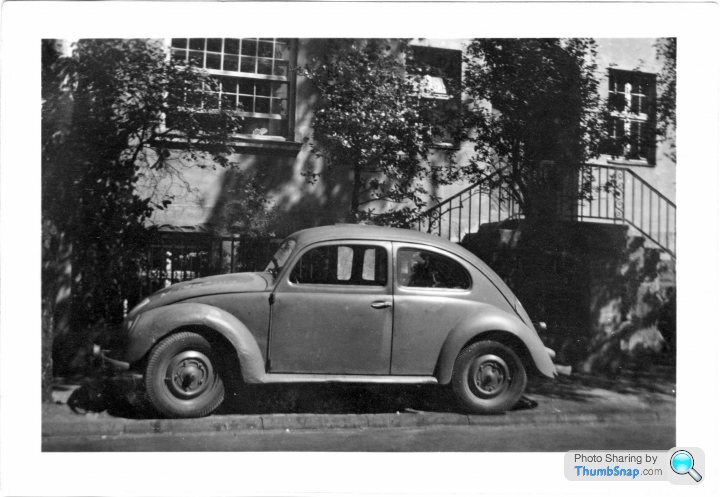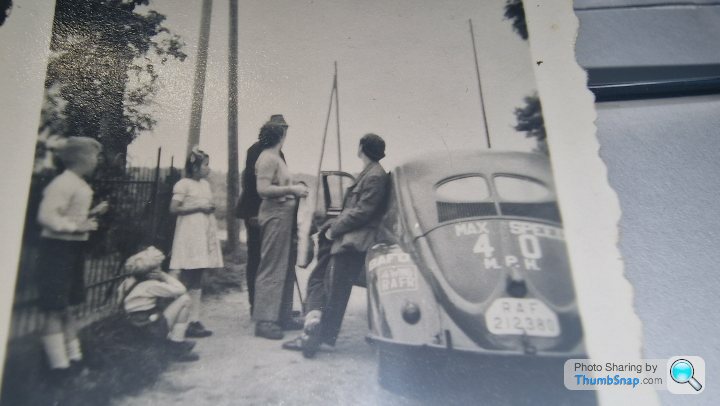The origins of VW
Discussion
Riley Blue said:
I don't recall such a link so had a quick flick through Ferry Porsche's 'Cars are my Life' and K.B. Hopfinger's 'Beyond Exectation, the Volkswagen Story' - no sign of an Austin connection. You weren't mistaking Volkswagen with BMW which did have a licensing deal with Austin?
Aye, your right I think - BMW.........Martin315 said:
BMW started making Austin 7s under licence as did Datsun/Nissan.
Major Hirst reopened the VW factory after the war and the Beetle was offered to Austin (and others, I think?) but they turned it down.
Not sure there was any Austin input pre-WW2.
Interestingly, Bantam Cars in the USA also originally manufactured Austin 7s Major Hirst reopened the VW factory after the war and the Beetle was offered to Austin (and others, I think?) but they turned it down.
Not sure there was any Austin input pre-WW2.
https://en.wikipedia.org/wiki/American_Austin_Car_...
Bantam were later the designers of the Jeep - though actual manufacturing was down to Willys & Ford.
Jaguar (as in Swallow Sidecars) and Jensen also started off as coachbuilders of Austin 7s.
Colin Chapman, John Haynes (Haynes manuals), Eric Broadley (Lola), Jem Marsh (Marcos) & Bruce McLaren all started as Austin 7 'special' builders
I remember reading that it was the global success of the Austin 7 that standardised pedal layout across the world.
ie A B C (transposed alphabet) (accelerator, brake, clutch). Prior to that pedal order was whatever was convenient to individual manufacturers.
Martin315 said:
BMW started making Austin 7s under licence as did Datsun/Nissan.
Nissan didn't make Austin 7s under license. There was some pre-war 'interest' from Austin when in 1935 they purchased a Type 14 Datsun in order to examine it and see if there had been any infringement of Austin patents etc, but none was found. That Datsun car is now an exhibit at the National Motor Museum, Beaulieu.Nissan had a post-war tie-up with Austin, starting out with CKD kits of the A40 in 1952. The agreement was that Japanese content would gradually increase as more and more manufacturing capability became possible. Within a few years 100% Japan-made Austins were coming off the production lines. Nissan owed a lot to the Austin tie-up.
Postwar, a VW was shipped to England and assessed by the major car makers. The offer was to take over the VW factory lock stock and barrel. Morris staff at Nuffield are recorded to have rejected it. William Rootes lead a commission to Germany to check out the site, but decided it needed too much work. Wolfsberg was in the British zone, and nominally, each occupying power was responsible for the economy there. They needed Germany to get back to work, but also start exporting again. Pre-war, Germany was a major exporter. The British zone was mostly agriculture, and they had a hard time getting that kick started again. Countries like the Netherlands had economies dependant on German exports. The British Military government thought there was a useful cross over in getting the factory active doing something (originally to service army trucks), thus also fulfilling a British requirement. The offer was for Rootes to take over the factory, and VW joining Hillman, Humber etc. Its reported that in 1945-48, the Beetle was a pretty rough product. The former Opel engineer the British appointed to run the factory basically said the car was terrible. It was this Heinz Nordhoff who made the VW a great car, not Porsche.
When the British turned down the VW, they weren't fools. What they were shown was a crappy half developed car, probably funded through a scam, a bombed out factory with half the workforce dead or gone. They didn't employ anyone like Nordhoff, who did what was then some pretty unorthodox things to improve the product ("service first, sales second"). Nor does it seem did anyone else, as Ford came to the same conclusion as Rootes.
Major HIrst was part of the VW survival story of course, but he was probably right, if it wasn't him, then it would have been someone else.
https://www.keymilitary.com/article/major-interven...
The irony was Nordhoff lived in the American zone. Because he had been given a Nazi award (when working for Opel), the Americans barred him from anything but working as a labourer (he was classified as a Nazi Affiliated Industrialist. He lead the launch of the Opel Kadett, and then headed Opel's commerical vehicle operation from 1942, which was churning out tons of Opel Blitz trucks), he moved to Hamburg to run the the service desk at an Opel dealership. He must have come into contact with then British authorities (perhaps the garage undertook work for the British), and was recruited by Hirst.
He seems to have been more keen on Ford taking on a share of the factory. He and Col. Radcliffe, who was Hirst's CO, worked on a plan for a part share of the factory, but Ford wanted 100% ownership or nothing.
The Beetle wasn't a great design. It didn't go on to influence a whole raft of rear engined small economy cars. But Nordhoff made it dependable.
When the British turned down the VW, they weren't fools. What they were shown was a crappy half developed car, probably funded through a scam, a bombed out factory with half the workforce dead or gone. They didn't employ anyone like Nordhoff, who did what was then some pretty unorthodox things to improve the product ("service first, sales second"). Nor does it seem did anyone else, as Ford came to the same conclusion as Rootes.
Major HIrst was part of the VW survival story of course, but he was probably right, if it wasn't him, then it would have been someone else.
https://www.keymilitary.com/article/major-interven...
The irony was Nordhoff lived in the American zone. Because he had been given a Nazi award (when working for Opel), the Americans barred him from anything but working as a labourer (he was classified as a Nazi Affiliated Industrialist. He lead the launch of the Opel Kadett, and then headed Opel's commerical vehicle operation from 1942, which was churning out tons of Opel Blitz trucks), he moved to Hamburg to run the the service desk at an Opel dealership. He must have come into contact with then British authorities (perhaps the garage undertook work for the British), and was recruited by Hirst.
He seems to have been more keen on Ford taking on a share of the factory. He and Col. Radcliffe, who was Hirst's CO, worked on a plan for a part share of the factory, but Ford wanted 100% ownership or nothing.
The Beetle wasn't a great design. It didn't go on to influence a whole raft of rear engined small economy cars. But Nordhoff made it dependable.
Yertis said:
The Beetle itself was following pre-war trend to put the engine at the back, see also Tatra 77.
Was it really a: "trend"? 
A couple of manufacturers looked into the concept, and built cars around it, as has happened quite a few times over the years, but the vast majority of manufacturers didn't bother with it, and stuck to the then traditional, engine in the front/driven wheels at the rear layout.
4rephill said:
Yertis said:
The Beetle itself was following pre-war trend to put the engine at the back, see also Tatra 77.
Was it really a: "trend"? 
A couple of manufacturers looked into the concept, and built cars around it, as has happened quite a few times over the years, but the vast majority of manufacturers didn't bother with it, and stuck to the then traditional, engine in the front/driven wheels at the rear layout.
Risonax said:
The offer was for Rootes to take over the factory, and VW joining Hillman, Humber etc. Its reported that in 1945-48, the Beetle was a pretty rough product.
Many years ago I saw an article in, I think, "Old Motor" which said that Rootes weren't convinced by the rear engined air cooled concept. A ten years later, they did the Imp, a rear engined car.Yertis said:
4rephill said:
Yertis said:
The Beetle itself was following pre-war trend to put the engine at the back, see also Tatra 77.
Was it really a: "trend"? 
A couple of manufacturers looked into the concept, and built cars around it, as has happened quite a few times over the years, but the vast majority of manufacturers didn't bother with it, and stuck to the then traditional, engine in the front/driven wheels at the rear layout.
https://www.keymilitary.com/article/major-interven...



I'm seeing fields full of crashed Beetles, most likely 6-12 months old. Crashed because of dreadful driving conditions/standards, or mechanical failure? With British soldiers effectively doing the reliability testing that hadn't been done in the previous 7 years (only a handful of saloons were made during the war, mostly for Party officials, most product was for Kubelwagons, which shared some features only).
Risonax said:
Postwar, a VW was shipped to England and assessed by the major car makers. The offer was to take over the VW factory lock stock and barrel.
And the rest above
This is the most concise and accurate account of the beginnings of post war Volkswagen I have read. As an ex long term Volkswagen employee the subject is close to my heart. Thanks for posting Risonax.And the rest above
Actually, around 100 prototype Volkswagens were built up to 1940 and subjected to an intensive testing programme. If you can get a hold of Chris Barber’s book, Birth of the Beetle, it goes into the pre-war development of the Beetle in great detail. Of course, the first post-war Beetles suffered from being built in a bombed-out factory with various parts, materials and labour problems. Another good book is Karl Ludvigsen’s Battle for the Beetle, which covers the postwar proposals for the Volkswagenwerk in some depth.
By the way, here's a photo of what appears to be a British Army Beetle my father took on 30th August 1947, when he was doing his national service with BAOR in Germany. I'm guessing it was the first time he had seen one. He must have asked someone what it was called, because he's written "Vax Wagon" on the back!


Gassing Station | Classic Cars and Yesterday's Heroes | Top of Page | What's New | My Stuff




